The Hungarian Armoured Personal Carrier
The Soviet BRDM-2 was widely adopted by the Warsaw Pact and appreciated as cheap, simple and versatile. Soon it appeared ideal to be copied by local industries, Hungary being such adopting country. The D-442 FUG (Felderítő Úszó Gépkocsi or "amphibious reconnaissance vehicle") was the first developed, relatively close to the original in design and concept, but soon was developed a more offensive variant called the D-944 PSZH (Páncélozott Személyszállító Harcjármű or "armored personnel carrier"), cheaper and still amphibious. It was also exported to East Germany as the Schützenpanzerwagen PSH, and exported to Slovakia and Iraq. The last were still in operations in the 1990s.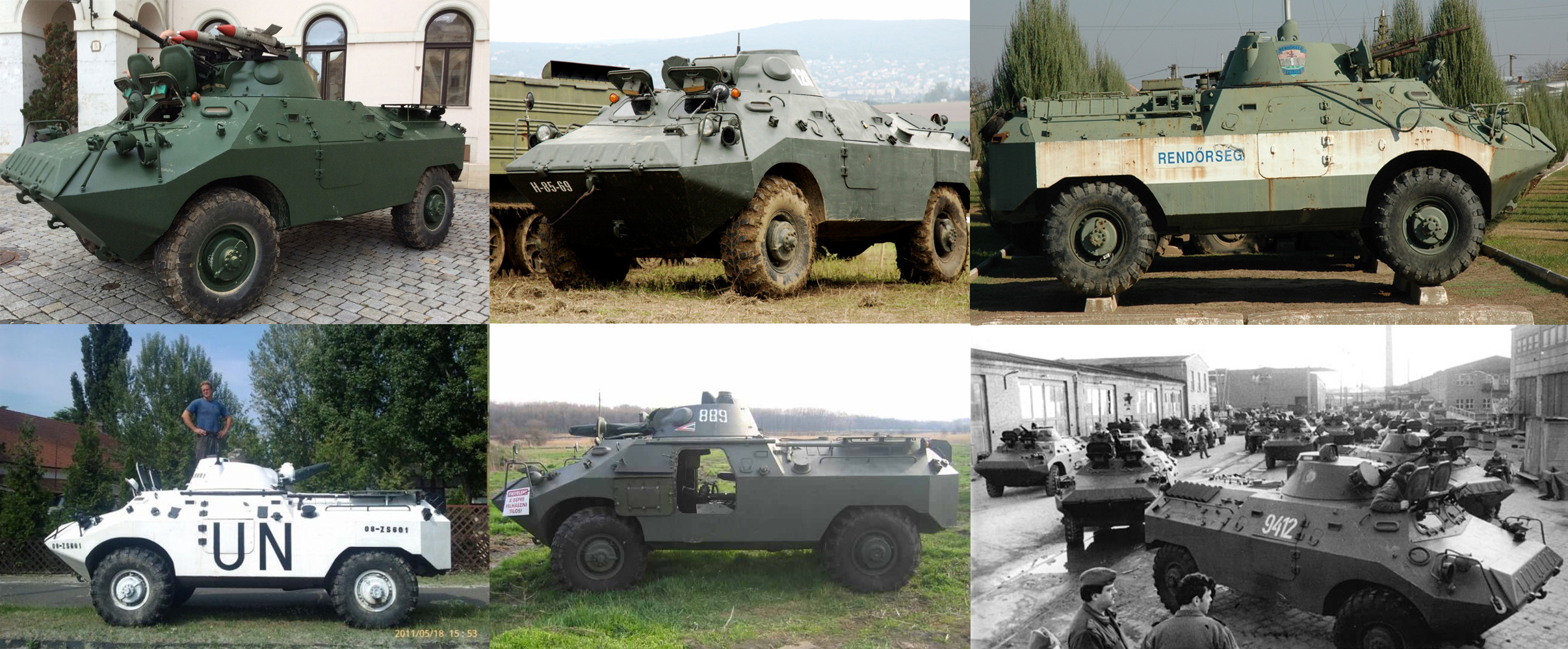
Production of both the FUG and SPZH, given Hungary lacked mass-production facilities, only managed a delivery rate sufficient enough to cover the country's armoured forces and little more. It was a complement to Soviet hardware and could be exported in the Warsaw Pact or abroad if needed. In general there was a greater attention to quality and manufacturing standards than in USSR, while keeping it cheap. Hungary refused in fact an offer for the BRDM-2. However the SPZH remained in the Warsaw Pact, the foreign export being ever being Iraq, and only for the SPzH. The acronym meant páncélozott szállító harcjármû for "armored transport fighter vehicle" which is as much an APC and IFV.
Development of the PSzH
Since the early 1960s, engineers considered a better armed variant of the D-442 reconnaissance vehicle. It was to be still be made domestically, and planned through the experience of the second Five Year Plan. Hungarian requirements from foreign partners were cancelled at the final stage of the conciliation and in third five year plan requirements of 1964, the defense ministry expressed the need for an "armored carrier fighter vehicle". On goal was to capitalize on the previous vehicle, and preservaed its good performances. In the early development phase, the military wrote the tactical & technical requirements (TTZ) for it, to carry 9 infantry in addition to the crew and a solid turret-mounted armament able to bring fire support.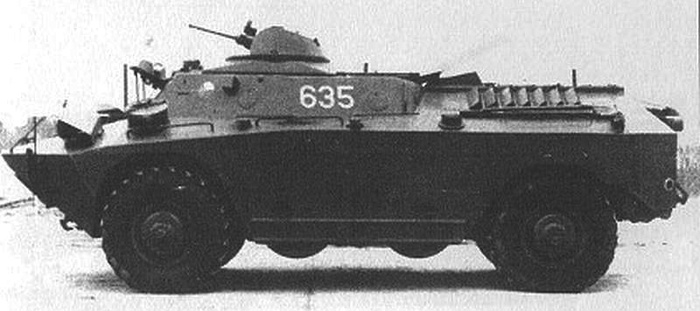
Initially the engineers were very ambitious, they managed for the first seven prototypes to give the original D-442 a pear-shaped turret strong enough to carry and house a 20mm gun, in cast steel. However the manufacturing in serie of said cast turret soon proved impossible. Down to a more conventiional rolled steel cone type turret, it was decided to fit a 14.5 mm machine gun, basically the same arrangement as in the BRDM-2, which was however a reconnaissance vehicle at heart, not an APC. The new turret measured 1,440 mm in diameter, and was rotated by simple manual drive on roller bearings, as its mounted cradle for the Soviet-procured KPVT HMG (same as the BRDM-2 again), with howeter domestic double-action sights.
This experiment was completed in the second half of 1966, as the four vehicles fitted with the said new turret were tried. Military and industrial experts led operational safety tests, then fire tests, resulting in a report and 68 modifications, underlying serious shortcomings. In November-December 1967 one of the first correction was the full sealing of the hull, which was not compatible NBC, and reducing the noise level, both inside and outside. Many more points were ironed out for a production documentation. The whole development was led by the Hungarian Military Technology institute, with the collaboration of Vehicle Development Department of the Rába Hungarian Wagon Workshop. Rába wa sindeed known for its trucks production prewar and still made new models in the cold war. Tests went on along 1969-71 to perfect the model for production.
Production of the páncélozott szállító harcjármû
In 1971, the definitive D-944 was approved for production and over the years, a total of 2,848 were made (according to globalsecurity.org). The vehicle was turned into four internal modifications, the initial D-944-00, the D-944-21, 22, 31, and D-944 M as the D-944-77 for border guards. 1,337 went to the Hungarian Army and Border Guards, of which 220 vehicles were D-944M variants. Foreign orders amounted to 1,363 D-944-40/41/42 for East Germany, 150 for Iraq, of the D-944-50/53 sub-variants.The production run was over almost a decade, starting in late 1971 and ending in 1980, all by Rába. If anything, it restored national confidence in the Hungarians into their own capabilities and industrial skills. The PSZH's career did not ended after the fall of the USSR but as Hungary entered the UE, and NATO, its equipment was standardized, and the vehicle was only retained by the Police, the remainder in depots being sent to South Yemen, still fighting there in diverse hands. Very little data exists on the Iraqi 150 vehicles, but they took part in the Iran-Iraq war and the remainder was destroyed in the 1991's gulf war.
It was by all accounts, a far better machine, more advanced than the D-442 and production reflected this, with far more APCs (D-944) delivered than recce D-442s. Unlike the BRDM-2 it corrected the awful entry/exit of the BRDM-2 and NBC forced the removal of roof hatches present on the D-442 FÚG. Buoyancy was however degraded as the vehicle was heavier. The original D-442 hull design was reused in general with the same shapes, including the nose, which was a bit "boat like" for acceptable swimming performances.
Design of the PSzH
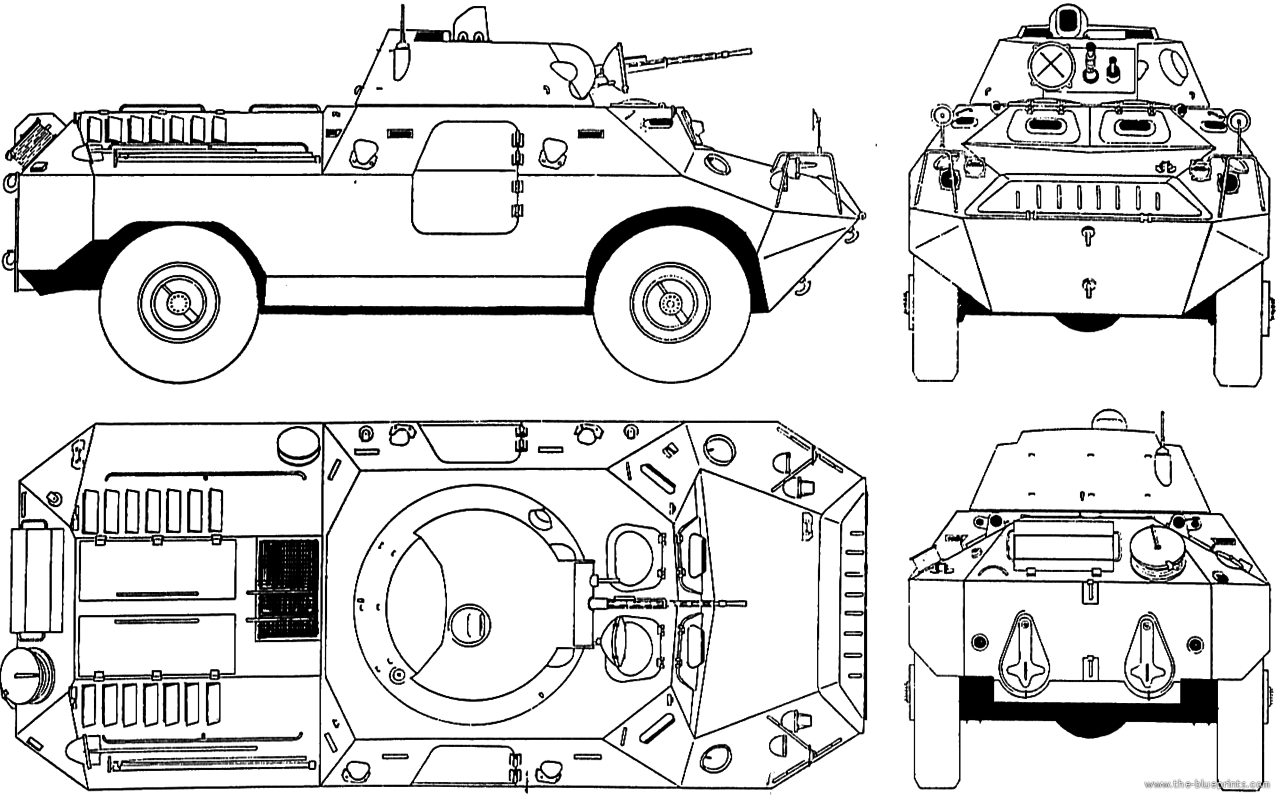
PSZH IV
The D-944 PSZH developed in late 1960s was a heavier main armoured personnel carrier for the Hungarian Armed Forces, still usable for police roles, used by the border guard and internal security services. The resemblance, chassis, and similar dimensions made it a very different vehicle still compared to the previous D-442. It had a modified armour nose, a two-part side door, none of the auxiliary belly wheels of the latter, and a roughly similar turret as the BRDM-2, modified and improved. The major difference was of course its much more potent 14.5 mm KPVT heavy Machine Gun, completed by a coaxial KPT 7.62 mm. However armor figures and powerplant were the same, allowing a much larger commonality across the board.
General Layout
PSzH D-944 back, showing the propeller well lids
The final design of the PSZH created an all-wheel-drive, 4-axle and single wheel with independent wheel suspension and amphibious armored transport/fighter vehicle, standardized from the D-566 military off-road truck. Engine, running gear, suspension, brake and winch were all reused.
The D-944 PSzH was designed to carry 6 troops in addition of 3 men crew, Commander and driver at the front, gunner in the one-man turret. Protection was raised for the front to 14 mm (0.5 inches) plus the slopes and extra trim vane, making for a capacity to resist 15 mm AP rounds and even 20 mm HE rounds. Also a major addition for the Hungariant Forces, it added a collective NBC protection and both for the gunner and driver, infrared night-vision.
The vehicle's nose housed the main drive system and transmission, with the winch, and after the trim vane were located two sets of lights/blackout lights protected by brush guards, and the back mirrors mounted on top. They could be folded to avoid damage.
The main driving cabin with the driver and commander's seats had two forward lifting shutters for relatively good vision when not under fire. Thus, glass windows were thick but not fully armored. In case of coming under fire, both shutters closed and vision was through well protected sights, with armoured class. They could not be opened from the outside. Both the commander and driver had small front opening accessed hatches on the cabin's roof. The commander had a rotating dome vision device built into his hatch.
There were two more encased sights on the three faceted upper cabin, facing either side, and then two small vision blocks along the hull, plus twin side doors, opening forward. The upper part could be opened from the outside. The engine was at the rear, separated from the troop compartment by an hermetic wall. There was also an intercom for the commander, driver, gunner and troops to stay in contact at all times despite the noise.
The turret was given a KM-1 main sight as well as two TVN-2 IR spotlights, one next to the armament, second one on top of the turret. There was a radio antenna at the turret's back, for a R-113 radio with R-142 emitter.
Armoured Protection
The armor was self-supporting, hermetically sealed and able to float due to basic buoyancy. Thickness was up to 20mm forward, albeit 14 mm is the usual figure, the 20mm being probably the equivalent due to sloping. The rest was protected by a minimun of 4mm (underbelly, roof, engine deck) and 8 mm for the rest of the hull exposed to ground fire. The hull was well angled, assembled by welding plates of a defined shape over a steel frame. Four high-strength steel tubes created a column supporting the heavy bottom plate. The armor could be able to withstand up to 30mm rounds at more than 500 meter away and protect the crew at all angles against artillery splinters and small arms fire from 100-200 meters away in all directions.The 1500 mm middle turret atop the hull was a simple cone made of rolled steel, and had suffucient protection (14 mm) against HMG rounds. It also had the gunner's main sight, rotating, and a set of four small vision periscopes behind it in a roof step aft. Behind the turret there were six seats (some sources goes as far as nine or 10 seats but this seems impossible). The central casemate had rear corners with vision blocks and around the side doors, two pistol ports to fire on the move. The left side armour is composed of five plates, four on the right side. The vehicle also had full NBC protection system but lacked any smoke dischargers for active concealment.
Armament
The turret houses the 14.5mm in a cradle mount which can elevate -5 and +30° while the turret provides a full 360° traverse. The KPVT has a rate of fire of 150 rounds per minute at max range 2,000m. AP ammunitions can penetrate 20 mm of armor at 1,000 m, 30 mm at 500 m. The 7.62mm PKT coaxial machine gun fires at 250 rounds per minute, max range 1,000m. The night vision enabled night combat as well but at shorter ranges due to the technology of the time.The PSZH carried 450 rounds for the 14.5mm machine gun and 1,750 rounds for the 7.62 mm machine guns, and a TVN-2 night vision device which completes the main day sight with a x6 mangification. The PSZH is capable of firing on the move, albeit the main KPVT heavy 14.5 mm machine gun is manually aimed. The coaxial KMG procures tracer fire enabling aiming. Troops can also fire from the four pistol ports around on the move. However the internal capacity for bulky weaponry (ATGM and MANPADS) is impossible due to the narrow doors.
Powerplant & performances
The D-944 houses the same 110W CSEPEL (100 hp) six-cylinder Diesel engine, type 414.44/2 in its engine compartment as for the D-442 FUG. The main change however is bigger wheels, which wheel rim is increased to house larger tire size. Top speed is about 80 kph on road, 30 kph off-road. Fully amphibious, for swimming it had its front trim vane erected, bilge pumps activated. The driver then engage water propulsion at the rear, with the two lids on the back plate protecting the propellers shifted either side. The vehicle is able to swim at 8-10 kph, however performances are degraded compared to the D-442 as the vehicle is heavier and sat lower in the water.If caracteristics stays the same compared to the FUG, the D-944 is able to cross a 1.2-meter trench, climb a 32 degree slope, ford any water surface, climb a vertical obstacle 40 cm high, 125 cm gap, and gradient up to 60%.
Variants
PSZH variants:
- PSZH 6x6 prototype built and tested
- PSZH-2, 8x8 variant with BMP-1 turre, paper only. (see later)
- D-944.00M PSzH-M (1988): R-123 radio, PKT instead of KGKT, 110 hp D-414.44/2 diesel
- D-944.00 PSZH-F Main APC for reconnaissance platoons/companies.
- D-944.77 PSZH border guard/police APC.
- D-944.31 SZDPK-PSZH: Company Command vehicle (2x R-123 radios+ antenna,+ R-107 radio, map-desk).
- D-944.21 ZPK-PSZH: Batallion Command vehicle (2x R-123, R-130, 2x R-107 radios, new right antenna).
- D-944.22 ZTÖF-PSZH: Mech. Bat. staff Command vehicle (R-123, R-130 radios, 2x R-107).
- D-944.21 OPK-PSZH: Towed arty Command vehicle (3x R-123MT radios, ET-68 laser-rangefinder turret, VOP right side, PKT).
OT-66
This is the name of the vehicle for the former Czechoslovakia, to be precise, OT-66 meant Obrněný Transportér vz. 66, as designation for the D-944 PSzH. No changes compared t the Hungarian production versions. Numbers are ellusive through. The extant vehicles were passed onto sucessors state, but only the Czech Republic in that case.Schützenpanzerwagen PSH (SPW-PSH, PSzH-IV)
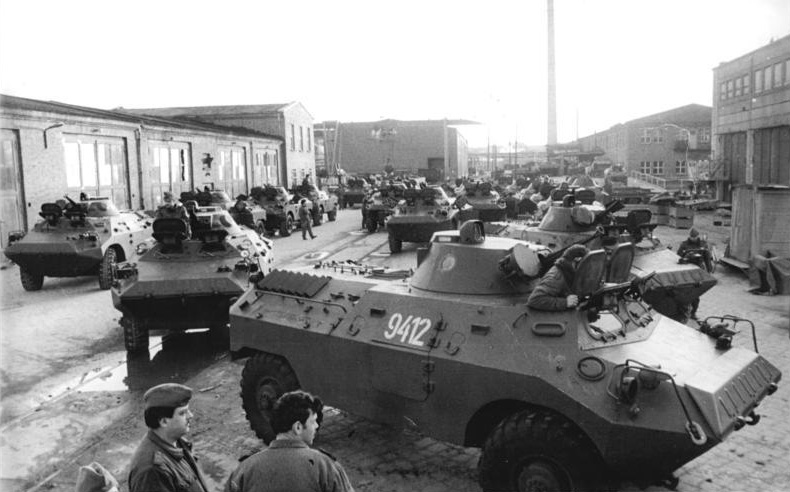
Grenz Polizei PSzH D-944 at NeuBrandenburg
This is the export version to East Germany of the vehicle, 1,363 delivered until 1980, used by the border guards (Grenztruppen). Changes are only cosmetic, the sub-versions are named D-944-40, D-944-41 and D-944-42. They simply sported the GDR roundel on the hull, and number on turret. The vehicle's large production meant several sub-variants were introduced specific to the East German needs:
The D-944.40 is the main Hungarian export designation also used in para-military units such as the Bereitschaftspolizei (riot police).
692 SPWs delivered according to wikipedia 1970-1976 were modified by Panzerwerkstatt-2 in 1979:
- SPW-PSH (Ch) 12 NBC reconnaissance vehicles (NBC detection, flag dispensers).
- SPW-PSH (Artl): 39 modified as artillery reconnaissance vehicles (border troops): Additional signals equipment, three rear whip antennae, optical range finder OEM-2 (big box on top of the engine deck).
- SPW-PSH (Pi): 28 Pionierwagen combat engineer recce vehicles (crew 7, portable mine detection MSG-46M, chain saw PS-90, etc.)
- SPW-PSH-Agitprop: Agitation and propaganda vehicle.
- D-944.41 PSzH-IV Battalion commander's vehicle, telescopic mast HTM-10 (K1).
- D-944.42 PSzH-IV Company commander's vehicle (K2).
- PSzH-IV-10: Turretless PSzH-IV, border guards.
Iraqi D-944.50/53
The D-944.50 was the export designation for Iraq and the D-944.53 PSzH-IV was its company commander variant.PSzH-2
Note that there was a 8x8 derivative called the PSzH-2 but which never reached production stage. it was much closer to a Piranha in general design and dimensions and used a new cast turret with the initially planned 20 mm gun. This was to be the next gen Hungarian APC in the 1980s. It shared little of anything with the previous vehicles. Two versions of the turrets were tested, the Polish creating the "Vidra" type housing a 30 mm gun and 7,62 mm coaxial. There was even a reinforced turret ring in order to support the BMP-1 turret and its low-pressure 73mm gun, coaxial and Malyutka ATGM. The PSzH-2 diesel engine is the Rába-MAN 2156 placed on the right side of the engine compartment, a 6-cyl. water-cooled rated for 170.2 kW. The PSzH-2 was never built, as its development ended as the USSR collapsed.Active service
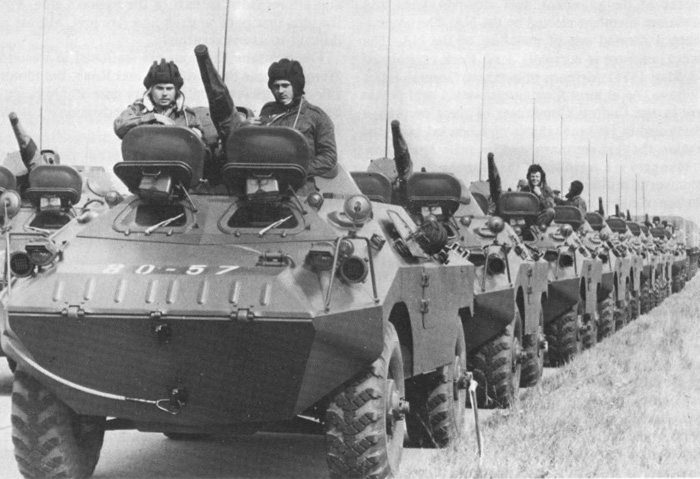
The vehicle entered service in 1971 and stayed so until 1991, and beyond, for a few years until the army was reequipped and reorganized under NATO standards. Many were exported to South Yemen according to some sources. The rest was placed in depots in apparently bad conditions, withdrawn from service today. The still existing vehicles has hulls in scarcely repairable condition. The Hungarian vehicle took part to no combat, same for the East German Vehicle, also stored in depots more rapidly than Hungary. It seem there were 50 vehicles still active at the time of the reunification according to some sources.
Of the 275 OT-65 of FUG D-442 ordered in 1965, received by 1968 and 200 PSzH acquired, designated OT-66. All in depots after 1992, withdrawn from service. So far only the Iraqi 200 (150 for other sources) were derlivered in 1981 and saw action both in the Iran-Iraq war and afterwards, retired and replaced by second hand BRDM-2s. The remainder were lost during the gulf war, some captured.
Sources/Links about the D-944
militarytoday.commilitaryfactory.com
globalsecurity.org
army-guide.com
warwheels.net
armedconflicts.com
old-forum.warthunder.com/
old-forum.warthunder.com/
militaertechnik-der-nva.de
D-944 specifications | |
| Dimensions | 5.79 x 2.50 x 2.10 m (19ft 2in x 8ft 2in x 7ft) |
| Total weight, battle ready | 7.4 tons (8.3 LT) |
| Crew | 3 (Driver, commander, gunner) +4-6 infantry |
| Propulsion | Csepel D414.44 in-line 4-cyl. OHV 5.5 l diesel 101 hp (75 kW) |
| Suspension | 4x4 Indep. leaf springs with hydraulic shock absorbers |
| Speed (road) | 13.5 hp/tonne, 81 kph road, 45 kph cross country, 9 kph water |
| Range | 500 km (310 miles) |
| Armament | 15.5 mm KPVT HMG, 7.62 mm LMG, personal weapons |
| Armor | 20 mm max front, 7 mm sides (0.5 in) |
| Total production | c2,850 1971-1980. |
Illustrations
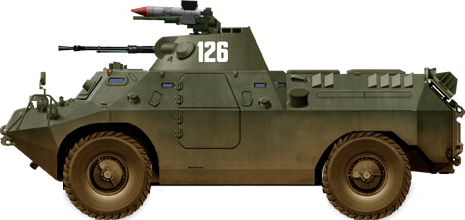
D-944 with 9M14P Malyutka ATGM
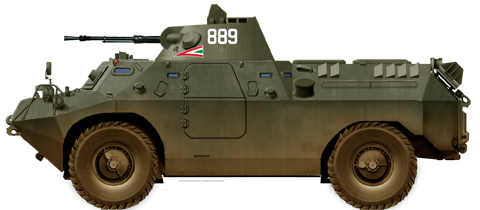
Hungarian PsZH IV
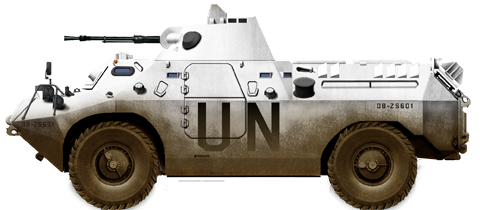
PsZH IB UN
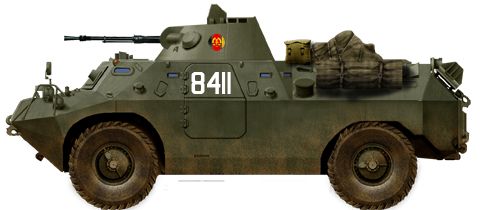
Schützenpanzerwagen PSH
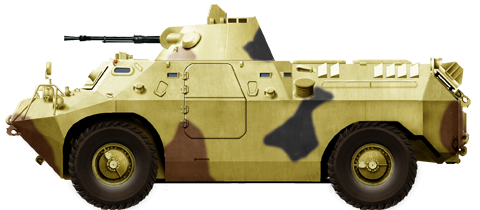
Iraqi vehicle, 1992
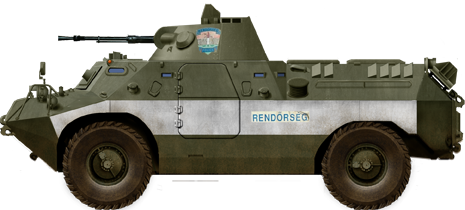
Hungarian Police
Gallery
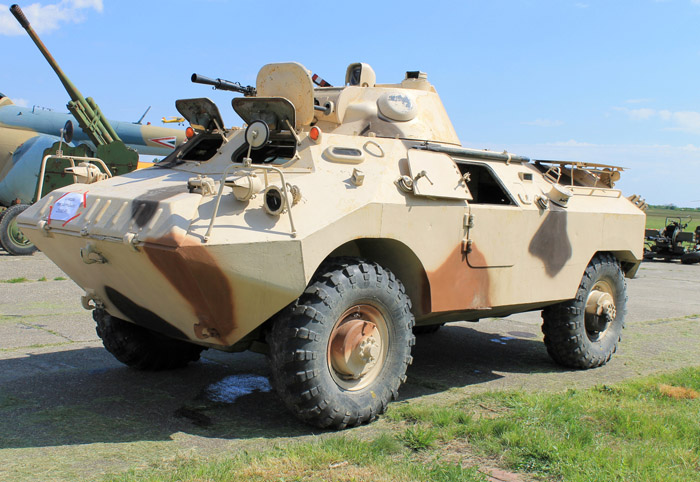
Iraqi SPzH (1990)
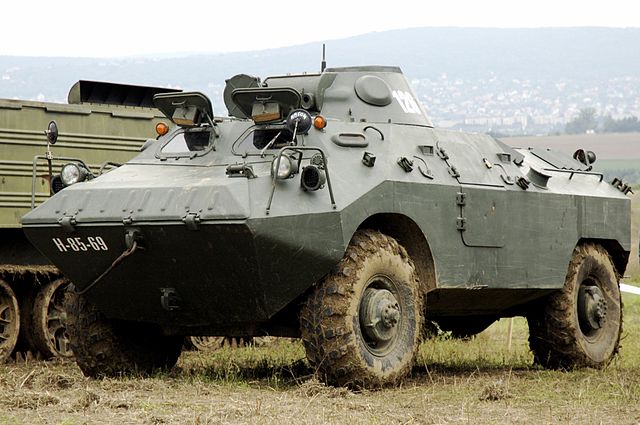
PSZH
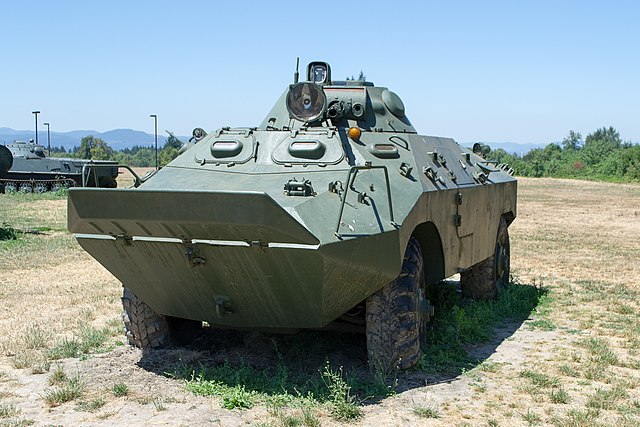
PSzH D-944
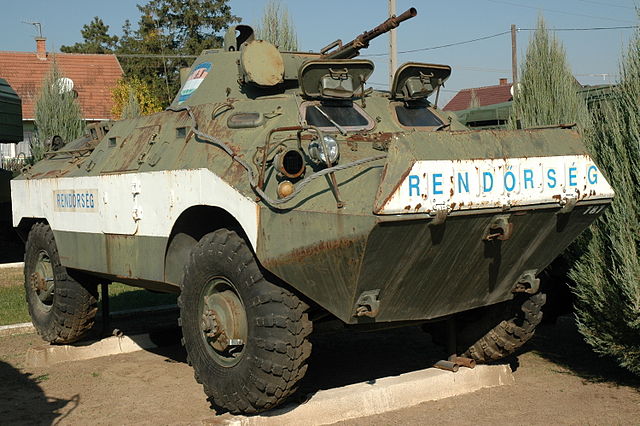
PSzH D-944 of the East German Police (Grenztruppen)
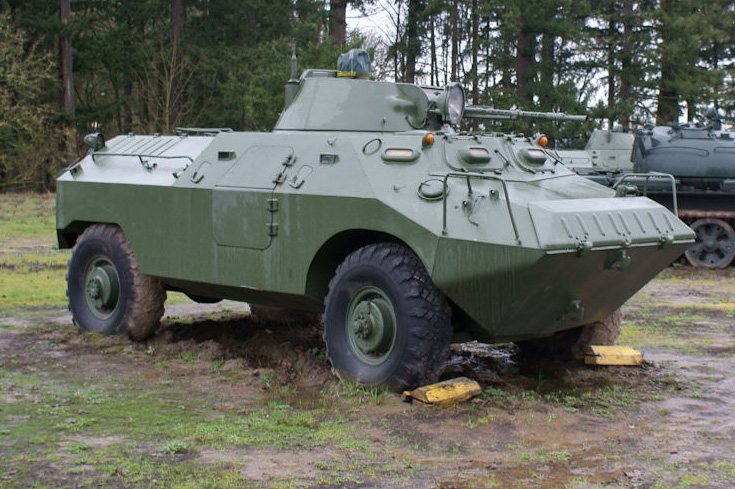
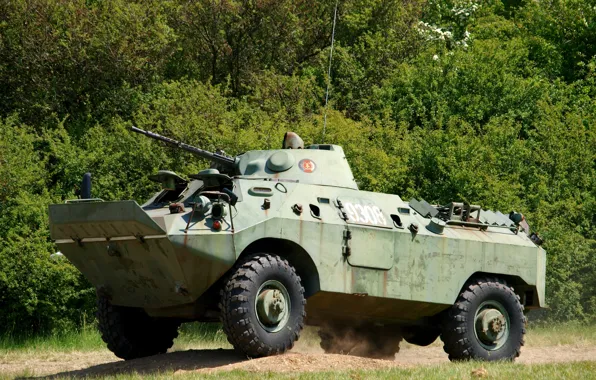
Video

Cold War Tanks


































Cold war tanks posters

Cold War Main Battle Tanks

Cold War Soviet Army
Museums, Movies, Books & Games
The Tanks and Armor in pop culture
Tanks and armored vehicles in general are only really grasped when seen first person: The mass, the scale, it's all there. Explore also the way tanks were covered in the movie industry, in books and in video games.Movies:
Best tanks movie on warhistoryonline.com
On imdb.com
On bestsimilar.com/
miltours.com
liveabout.com/
watchmojo.com
Video Games:
pcgamesn.com
historyhit.com
levvvel.com
vg247.com/best-tank-games
mmobomb.com/
alienwarearena.com

 Armored Fighting Personal Carrier, 2,848 built
Armored Fighting Personal Carrier, 2,848 built